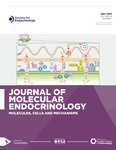RECENT RESEARCH ON THE GROWTH PLATE: Impact of inflammatory cytokines on longitudinal bone growth
- 1Pediatric Endocrinology Unit Q2:08, Department of Women's and Children's Health, Karolinska University Hospital, SE-171 76 Stockholm, Sweden
2Developmental and Stem Cell Biology, The Hospital for Sick Children, University of Toronto, Toronto, Ontario, Canada
- Correspondence should be addressed to L Sävendahl; Email: lars.savendahl{at}ki.se
-
Figure 1
Growth plate ultrastructure, and the GH/IGF1 axis, a major regulator of longitudinal bone growth. GH has both direct effects on the growth plate as well as indirect effects through IGF1. The growth plate is a complex structure consisting of chondrocytes at different stages of differentiation. It is divided into three specialized zones: the resting zone, proliferative zone, and hypertrophic zone.
-
Figure 3
(a, b, and c) TNFα, IL1β, and IL6 impair longitudinal bone growth in fetal rat metatarsal bones. TNFα (a) and IL1β (b) have a dose-dependent effect. IL6 together with IL6 Rα impairs bone growth in fetal rat metatarsal bones (c). TNFα and IL1β have a synergistic effect, but the involvement of IL6 does not have any further synergistic effect (c). Fig. 3a and b are adapted from Martensson et al. (2004), with permission from the American Society for Bone and Mineral Research. © 2004 ASBMR.
- © 2014 Society for Endocrinology











